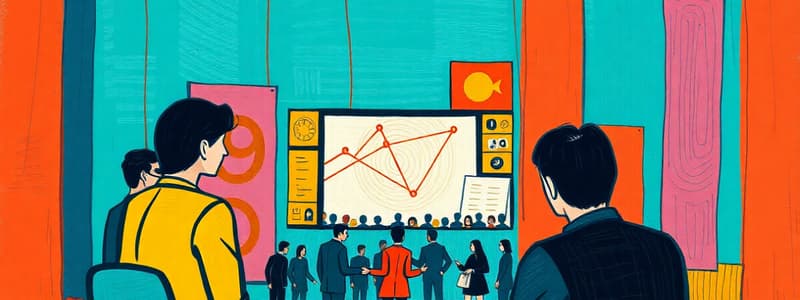Podcast
Questions and Answers
How do Teal organizations differ from traditional organizations in their decision-making processes?
How do Teal organizations differ from traditional organizations in their decision-making processes?
- Teal organizations make decisions based on individual opinions, while traditional organizations focus on making unbiased decisions without opinions.
- Teal organizations prioritize trust and shared vision in collective decision-making, whereas traditional organizations depend on rigid structures. (correct)
- Teal organizations avoid decision-making altogether, focusing solely on employee satisfaction, unlike traditional organizations.
- Teal organizations rely on rigid hierarchies for decision-making, while traditional organizations embrace collective decision-making.
According to Laloux's framework, what organizational paradigm is best suited for fostering employee collaboration, engagement, and empowerment?
According to Laloux's framework, what organizational paradigm is best suited for fostering employee collaboration, engagement, and empowerment?
- The Conformist paradigm, characterized by its emphasis on strict hierarchy, fixed rules, and fear based regulation within an organization.
- The Impulsive paradigm, which thrives on centralized power, fear-based rule, and individual competition to motivate employees effectively.
- The Pluralistic paradigm, known for its collaborative and employee-centric approach, but can sometimes struggle with scalability. (correct)
- The Evolutionary paradigm, renowned for its self-management approach, evolving purpose, and strict adherence to established hierarchies.
What is the primary implication of 'flattening organizations' through IT implementation on the roles and control of middle managers?
What is the primary implication of 'flattening organizations' through IT implementation on the roles and control of middle managers?
- IT implementation reinforces the importance of middle managers by providing them with more data for decision-making, increasing the size of the workforce they control.
- IT implementation leads to the elimination of lower level employees, leaving middle managers in control of the technology used in the organization.
- IT implementation has no impact, leading to the creation of more middle management roles, requiring them to mediate between high-level management and lower-level management.
- IT implementation leads to a significant reduction in the number of middle managers needed, as technology enables high-level managers to oversee a larger, more dispersed workforce effectively. (correct)
Drawing from Leavitt's model, what is the most critical approach an organization must adopt when introducing a new information system to ensure holistic and effective change?
Drawing from Leavitt's model, what is the most critical approach an organization must adopt when introducing a new information system to ensure holistic and effective change?
What foundational elements constitute an information system, as defined beyond a purely technical standpoint?
What foundational elements constitute an information system, as defined beyond a purely technical standpoint?
Given the interrelation between information technology and organizational structure, what key factor is most influential in mediating their interaction?
Given the interrelation between information technology and organizational structure, what key factor is most influential in mediating their interaction?
How does the implementation of IT systems impact the distribution of information and decision-making processes within an organization?
How does the implementation of IT systems impact the distribution of information and decision-making processes within an organization?
Why is organizational and political resistance, rather than technological failure, cited as the primary reason for the failure of large projects?
Why is organizational and political resistance, rather than technological failure, cited as the primary reason for the failure of large projects?
What critical organizational aspects must decision-makers consider to ensure the successful design and implementation of information systems?
What critical organizational aspects must decision-makers consider to ensure the successful design and implementation of information systems?
Which of the following paradigms puts emphasis on strict hierarchy and fixed rules?
Which of the following paradigms puts emphasis on strict hierarchy and fixed rules?
What is emphasized in the Pluralistic Organizational Paradigm?
What is emphasized in the Pluralistic Organizational Paradigm?
What is the emphasis in the Evolutionary organizational Paradigm?
What is the emphasis in the Evolutionary organizational Paradigm?
According to Drucker (1988), what is the primary shift that occurs in the decision-making process when organizations flatten their structure through increased information distribution?
According to Drucker (1988), what is the primary shift that occurs in the decision-making process when organizations flatten their structure through increased information distribution?
What is needed with self-managing teams?
What is needed with self-managing teams?
What is a primary concern when implementing self-managed teams?
What is a primary concern when implementing self-managed teams?
How can information systems contribute to an organization's competitive advantage?
How can information systems contribute to an organization's competitive advantage?
What does the implementation of new IT systems have an effect on?
What does the implementation of new IT systems have an effect on?
What should be adjusted according to Leavitt in order to achieve effective results?
What should be adjusted according to Leavitt in order to achieve effective results?
How do blockchain transactions affect an individual's personal information?
How do blockchain transactions affect an individual's personal information?
What are the main processes affected by the usage of Information Systems?
What are the main processes affected by the usage of Information Systems?
In the context of organizational paradigms, which paradigm is most closely related to concepts such as agility and lean management?
In the context of organizational paradigms, which paradigm is most closely related to concepts such as agility and lean management?
How does a Decentralized Autonomous Organization differ from a traditional organization?
How does a Decentralized Autonomous Organization differ from a traditional organization?
How does blockchain technology change traditional notions of employment within organizations?
How does blockchain technology change traditional notions of employment within organizations?
What does a Smart Contract rely on to execute automatically?
What does a Smart Contract rely on to execute automatically?
What are the benefits of Smart Contracts?
What are the benefits of Smart Contracts?
What does Leavitt's model suggest about changing certain components of the organization?
What does Leavitt's model suggest about changing certain components of the organization?
HRIS is an information system that facilitates management of...
HRIS is an information system that facilitates management of...
Flashcards
Teal Organization
Teal Organization
Organizations where employees collectively make decisions based on trust and shared vision, embracing a living-system approach to adapt organically.
Impulsive Paradigm
Impulsive Paradigm
Centralized power, fear-based rule.
Conformist Paradigm
Conformist Paradigm
Strict hierarchy, fixed rules.
Achievement Paradigm
Achievement Paradigm
Signup and view all the flashcards
Pluralistic Paradigm
Pluralistic Paradigm
Signup and view all the flashcards
Evolutionary Paradigm
Evolutionary Paradigm
Signup and view all the flashcards
Information Systems Definition
Information Systems Definition
Signup and view all the flashcards
Work System
Work System
Signup and view all the flashcards
Information Systems Impact
Information Systems Impact
Signup and view all the flashcards
Organizational Implication
Organizational Implication
Signup and view all the flashcards
Mediating Factors
Mediating Factors
Signup and view all the flashcards
IT Flattens Organizations
IT Flattens Organizations
Signup and view all the flashcards
Resistance to Change
Resistance to Change
Signup and view all the flashcards
Leavitt’s Diamond
Leavitt’s Diamond
Signup and view all the flashcards
Organizational Resistance
Organizational Resistance
Signup and view all the flashcards
Design Information Systems
Design Information Systems
Signup and view all the flashcards
CRM
CRM
Signup and view all the flashcards
SCM (Supply Chain Management)
SCM (Supply Chain Management)
Signup and view all the flashcards
HRIS
HRIS
Signup and view all the flashcards
ERP
ERP
Signup and view all the flashcards
Business Intelligence
Business Intelligence
Signup and view all the flashcards
Blockchain
Blockchain
Signup and view all the flashcards
Smart Contract Benefits
Smart Contract Benefits
Signup and view all the flashcards
DAO
DAO
Signup and view all the flashcards
Study Notes
Recap From Last Week
- Laloux focused on new organizational approaches due to the need for more adaptive, human-centered, and purpose-driven organizations.
- Teal organizations encourage collective decision-making based on trust and shared vision instead of rigid structures and use a living-system approach, adapting organically to changes.
- The 3 key principles of Teal organizations are: self-management, wholeness, and evolutionary purpose.
The 5 Organizational Paradigms
- The table outlines different paradigms according to Laloux.
- Impulsive organizations have centralized power using a fear-based approach (ex. Mafia).
- Conformist organizations have strict hierarchies and fixed rules (ex. Military, Catholic Church).
- Achievement-oriented organizations focus on goal attainment, competition, and performance (ex. Multinationals).
- Pluralistic organizations are characterized by collaboration and employee engagement (ex. Ben & Jerry's).
- Evolutionary organizations have self-management and an evolving purpose (ex. Buurtzorg, Patagonia).
Structure
- Part 1 focuses on defining organizations and organization theories.
- Part 2 addresses the challenges faced by organizations.
- Part 3 will look at designing organizational structures through specialization and coordination.
- Part 4 explores new challenges of organizational design alongside information technology.
Section 1 - The Value of Information Systems
- Companies today are environments where individuals constantly interact with technology.
- Technology impacts work, employment, and organizational design.
- Information systems have become essential, online, and interactive tools involved in the operations and decision-making within large organizations.
- In the previous decade, IS have altered the economics of organizations while increasing the possibilities for organizing work.
- Information systems consist of technology, people and processes
- Systems process and interpret information.
Organizational Implication of Integrating Information Systems
- Information systems work as elements for creating a competitive advantage (product variation, cost reduction, etc).
- Organizational adjustments and technology modification are needed to achieve this advantage.
- Interactions between information technology and organizations are complex and influenced by various mediating factors, including structure, business processes, politics, culture, environment, and management decisions.
How Organization Structures Change with New IT
- IT flattens organizations by distributing information to empower employees and increase the management effectiveness.
- High-level managers are better able to manage and control the workforce from long distances with IT.
- The integration of IT applications has led to the elimination of many middle management positions.
Implications of Flattening Organizations
- Decision-making processes need to become more decentralized.
- Professional employees should be self-managed.
- The traditional shape of organizations should become flatter.
Advantages of IT
- Flexibility for workers
- Faster team changes
- Cost reductions
Risks of IT
- Self-managed teams may move in the wrong direction.
- Difficult to evaluate individuals
- Workers may feel disoriented
New Approaches
- Evaluations, and organization
- Informing workers all require new approaches
Open Source World and Valve
- Empowerment enhances creativity and experimentation and distributed leadership is ideal for resolving conflict.
Information Systems and Organizational Affects.
- Information systems can affect who does what to whom, when, where, and how in an organization.
- When information systems are introduced, resistance can be expected.
- Leavitt (1965) proposed that simultaneously changing technology, tasks, structure, and people is necessary for the optimal results.
Causes of Failure in Reaching Objectives
- Organizational and political resistance to change, as opposed to technological limits.
Implications for Design and Understanding of Info Systems
- Delivering on reliable benefits to users
- Information systems need to be built within a clear understanding of the organization for it to be used
Factors of Design and Systems
- Organization must function within set environment
- Organizations hierarchy, specialization, and business processes must function properly
- Organizations Politics and Culture must be open to change
Organizational Traits
- Leadership must be in line with the system
- System must be in line with those of the working users
- Tasks, decisions, and working processes all must be considered with installation of the system
Types of Information Systems
- CRM (Customer Relationship Management) = Management of Customer relations: from pre-sales to post sales.
- SCM (Supply Chain Management) = Management of the supply chain (Supplier Relationship).
- HRIS (Human Resource Information Systems) = Management of human resources, careers.
- ERP (Enterprise Resource Planning) = Transversal IS.
- Business Intelligence = Decision support: transversal tool for strategic assistance.
Blockchain and Organizational Structure
- Blockchain = Decentralized autonomous organization
- Blockchain refers to a decentralized ledger that administratively stores user transactions across a network of computers.
- The transactional data within a blockchain is all made public.
- Privacy is maintained because transactions are made under pseudonyms.
Smart Contracts Advantages
- You make agreements directly with the end user, eliminating brokers, lawyers, notaries, to create and confirm transactions
- Reduced cost due to absence of a third party required to witness
- Stored, duplicated and encrypted and therefore it is impossible to lose or hack it.
- Software code executes Automatically, rendering manual processing unnecessary
- More efficient and less prone to errors
- Removes the intermediary
Distributed Automnomous Organizations
- DAO = Decentralized autonomous organization.
- Blockchain enables a new organizational form to emerge such as DAO.
- These organizations comprises of groups of people who work in defined “tribes", defined by software and incentivized by tokens.
- DAOs consist of members earning compensations from blockchain and that are working to achieve a common objective.
Checklist
- Define the concept of information system,
- List typologies and their role in organizations Explain the interdependence of the organizational structure
- Highlighting main impacts of structure.
- Describe mediating factors that influence the interaction between organizational structure and technology.
- Describe Leavitt's diamond to explain potential organizational resistance to change.
- List key organizational factors to consider when planning a new information system.
Studying That Suits You
Use AI to generate personalized quizzes and flashcards to suit your learning preferences.




